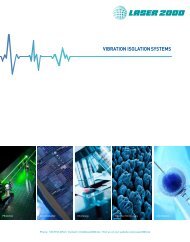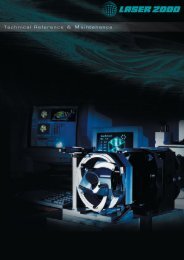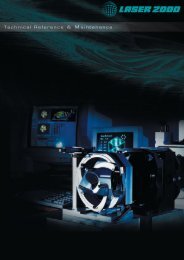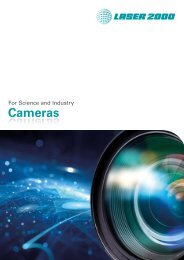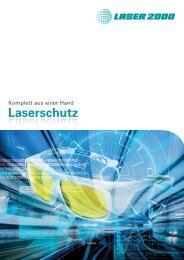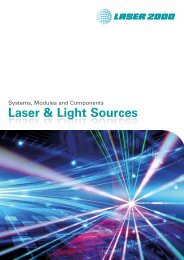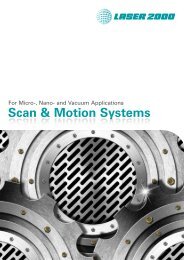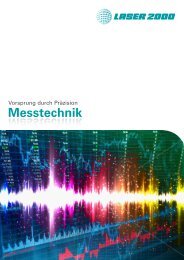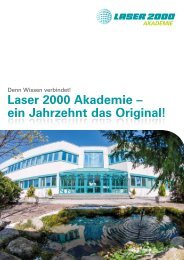Semrock Master Catalog 2018
Semrock Master Catalog 2018
Semrock Master Catalog 2018
You also want an ePaper? Increase the reach of your titles
YUMPU automatically turns print PDFs into web optimized ePapers that Google loves.
TECHNICAL NOTE<br />
Sputtered Thin-film Coatings<br />
Optical thin-film coatings can be deposited by a variety of methods. Traditionally the most popular methods for depositing multilayer coatings –<br />
required for higher-performance mirrors and filters – include thermal and electron-beam (e-beam) evaporation and ion-assisted e-beam evaporation<br />
(IAD). These have been in use for many decades. Films evaporated without ion-assist have several significant shortcomings that largely stem from<br />
the porosity of the resulting films. They are often referred to as “soft” coatings, because they are not very durable, they absorb water vapor which<br />
results in wavelength shifting, they also shift with temperature changes, and they can exhibit noticeable scattering. With additional energy from an<br />
ion gun directed at the substrate during the physical vapor deposition process, IAD coatings are sometimes referred to as “semihard” since they<br />
are appreciably more dense, resulting in significantly better durability and lower moisture absorption, temperature shifting, and scattering. With all<br />
evaporated film processes, variations in the vapor “plume” during the deposition process make it challenging to control the rate and uniformity with<br />
high precision, thus making it difficult to manufacture large volumes of complex filters with a high number of precise-thickness layers.<br />
Fluorophores<br />
Single-band<br />
Sets<br />
Deposition Process<br />
Resulting Thin Films<br />
Electron-beam /<br />
Thermal Evaporation<br />
Physical Vapor Deposition<br />
Ion-assisted Electron-beam<br />
Evaporation (IAD)<br />
Energetic Physical Vapor<br />
Deposition<br />
Sputtering<br />
Energetic Physical Vapor<br />
Deposition<br />
Variable deposition rates Variable deposition rates Extremely stable deposition rates<br />
Variable spatial uniformity Variable spatial uniformity Controllable spatial uniformity<br />
Soft coatings Semi-hard coatings Hard, dense coatings<br />
Low durability Moderate to high durability Very high durability<br />
Hygroscopic (absorb moisture) Minimally hygroscopic Impervious to humidity<br />
Appreciable temperature shifting Low temperature shifting Very low temperature shifting<br />
Some scattering Low scattering Very low scattering<br />
Some absorption Low absorption Very low absorption<br />
Low film stress Film stress Reproducible film stress<br />
Multiband<br />
Sets<br />
Cubes<br />
Laser<br />
Sets<br />
In contrast, <strong>Semrock</strong> manufacturers all of its optical filters with a deposition process called sputtering. This state-of-the-art technology was originally<br />
developed for coating precise ferrite thin films for magnetic disk drive heads, and then gained a reputation in the optics arena for fabrication of<br />
extremely low-loss mirrors for ring-laser gyroscope applications. In the late-1990’s it was adapted to manufacture the highest-performance optical<br />
filters for wavelength-division multiplexing in the booming fiber-optic telecommunications industry. Sputtering produces hard refractory oxide thin<br />
films – as hard as the glass substrates on which they are coated. This stable process is renowned for its ability to reproducibly deposit many hundreds<br />
of low-loss, reliable thin-film layers with high optical-thickness precision.<br />
One way to clearly see the difference among soft evaporated films, the more robust films<br />
produced with IAD, and the very dense, low-scattering films resulting from the sputtering process is to<br />
study the film surface morphology closely. Atomic force microscopy reveals surface characteristics<br />
indicative of the packing density of the films. The graph below shows results from a study that<br />
compared the three main deposition methods as well as two other less-common modified processes<br />
[1]. Films were coated on substrates with a starting root-mean-square (RMS) surface roughness below<br />
0.5 Å. Only sputtering produces highly multi-layered films with sufficient packing density to result in<br />
surface roughness comparable to that of the starting substrate.<br />
RMS Surface Roughness (Å)<br />
12<br />
10<br />
8<br />
6<br />
4<br />
2<br />
e-beam<br />
evaporation<br />
ion-assisted<br />
e-beam<br />
evaporation<br />
(IAD)<br />
plasma<br />
enhanced<br />
IAD<br />
substrate<br />
roughness<br />
ion<br />
plating<br />
ion-assisted<br />
ion-beam<br />
sputtering<br />
0<br />
[1] “Optical Morphology: Just How Smooth Is That Surface?,”<br />
C. Langhorn and A. Howe, Photonics Spectra (Laurin Publishing),<br />
June 1998.<br />
Assist<br />
Ion Beam<br />
Source<br />
Target<br />
Substrate<br />
Deposition<br />
Ion Beam<br />
Source<br />
A perceived limitation of the sputtering process has always been throughput – the excellent<br />
performance came at the expense of slow deposition rates and limited coating areas. For the<br />
established applications of disk drive heads and telecom filters with dimensions of only one to several<br />
mm at most this limitation was not too severe. However, it was considered a show-stopper for costeffective<br />
production of larger filters Door<br />
in higher volumes. <strong>Semrock</strong> broke<br />
through this limitation by turning<br />
sputtering into a true high-volume<br />
manufacturing platform for large<br />
(dimensions of inches) very high layer count optical filters.<br />
And we did this without compromising the optical performance for which<br />
sputtering was renowned, resulting from dense, low-scattering thin film layers<br />
of extreme optical-thickness precision. <strong>Semrock</strong> made ground-breaking<br />
developments in process technology to boost rates and uniformity, and we<br />
are continually improving the process even today. And our highly advanced<br />
deposition-control technology based on the proprietary hardware, algorithms, and<br />
software of <strong>Semrock</strong>’s “optical monitoring” system enables repeatable deposition<br />
of many hundreds of thin film layers of even arbitrary thickness for complex filters<br />
with superb spectral features.<br />
Pump<br />
Port<br />
Ion-assisted Ion-beam Sputtering<br />
NLO<br />
Filters<br />
Individual<br />
Filters<br />
Dichroic<br />
Beamsplitters<br />
Tunable<br />
Filters<br />
43<br />
More



